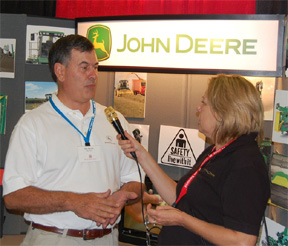Dean Foods, the nation’s largest milk processor, announced last week that it would cut 600 to 700 jobs, or roughly 2 percent of its workforce, to offset high input costs. “Rapidly increasing and record-high dairy commodity costs have created a very challenging operating environment, and 2007 results have been well short of our expectations,” says Dean CEO Gregg Engles. For more information
“Rapidly increasing and record high dairy commodity costs have created a very challenging operating environment and 2007 results have been well short of our expectations,” Chief Executive Officer Gregg Engles said. Shares of Dean Foods slipped almost 10% in Tuesday pre-market trading, but recovered to gain 12 cents, or 0.5%, to close at $26.41.
The Dallas-based company makes an assortment of food products, but its dairy division is the country’s largest processor and distributor of milk and dairy goods. As a major player in the dairy market, the company’s profit margin depends on low dairy prices.
In recent quarters, dairy commodity costs have reached all-time highs because of a number of factors. High fuel prices have incrementally increased the cost of transporting materials, while the rising cost of grain, which reflects the growing demand for corn and ethanol production, has made it more expensive to feed cows. Meanwhile, the global demand for non-fat dry milk powder is surging, as developing countries like China consume more milk.
“We face unprecedented cost challenges in our Dairy Group operations, including increased shrink costs and materially reduced profits from excess cream sales,” Chief Financial Officer Jack Callahan said. “At the same time, sales volumes in the Dairy Group have softened as consumers react to the record high prices.”
With dairy prices expected to stay sky high for the rest of the year, Dean Foods is far from reaching its initial sales targets. The company now expects to earn 15 cents a share in the third quarter — far below the previous range of 24 to 28 cents. In turn, Dean Foods now predicts it will earn $1.25 a share for the full year, which is also significantly below the previous range of between $1.52 and $1.58 a share.
The company said the dairy rut will continue to negatively impact earnings until the second half of 2008, when a growing milk supply is expected to ease dairy prices. For now, the company will focus on tightening its ship. It will immediately cut 600 to 700 jobs, or roughly 2% of the workforce. “Our decision is part of our multi-year productivity initiative which will help better position the company during this incredibly difficult period for Dean Foods,” CEO Engles said. “It is a tough decision, but it is a necessary action to improve our competitive position.”
Dean Foods’ dairy doldrums is certainly a disappointment, but it did not come as a complete surprise. Dairy costs have weighed on the company for multiple quarters. In August, the company said third quarter net income fell 1.7%, to $28.4 million, or 22 cents per share, from $28.9 million, or 21 cents per share, in the prior year’s corresponding period. The results missed Wall Street’s call by almost a dime; analysts were expecting 31 cents. In what has become a familiar refrain, Engles had said then that the company was struggling through a “difficult environment.”
 Select Sires Inc. has made a $1,750 donation to the American Jersey Cattle Association‘s (AJCA) scholarship funds to purchase the No. 7 giclée canvas print of “Wide Load Ahead.” The announcement was made at the opening of the Top of the World Jersey Sale held October 3, 2007 in conjunction with World Dairy Expo in Madison, Wis.
Select Sires Inc. has made a $1,750 donation to the American Jersey Cattle Association‘s (AJCA) scholarship funds to purchase the No. 7 giclée canvas print of “Wide Load Ahead.” The announcement was made at the opening of the Top of the World Jersey Sale held October 3, 2007 in conjunction with World Dairy Expo in Madison, Wis.
 You only thought we were done with stuff from World Dairy Expo.
You only thought we were done with stuff from World Dairy Expo.


 Dairy Markets Week in Review
Dairy Markets Week in Review Rising U.S. Dairy exports are being credited as one of the factors contributing to higher market prices this year. The
Rising U.S. Dairy exports are being credited as one of the factors contributing to higher market prices this year. The